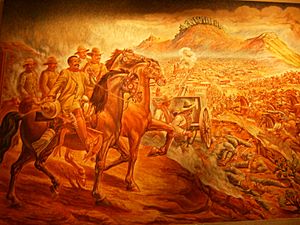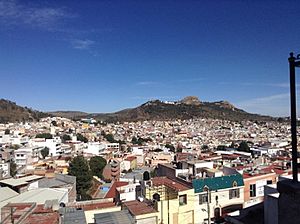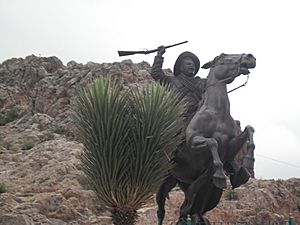Battle of Zacatecas (1914) facts for kids
Quick facts for kids Battle of Zacatecas |
|||||||
|---|---|---|---|---|---|---|---|
| Part of the Mexican Revolution | |||||||
 |
|||||||
|
|||||||
| Belligerents | |||||||
|
|
|
||||||
| Commanders and leaders | |||||||
| Strength | |||||||
| over 20,000 (estimate) | 7,000-15,000 (most likely 12,000) | ||||||
| Casualties and losses | |||||||
| 1,000 (estimate) | 6,000-7,000 (estimate) | ||||||
The Battle of Zacatecas, also known as the Toma de Zacatecas (Taking of Zacatecas), was a very important and tough battle during the Mexican Revolution. This battle helped to overthrow the Mexican President, Victoriano Huerta. On June 23, 1914, Pancho Villa's División del Norte (Division of the North) strongly defeated the government troops led by General Luís Medina Barrón. These troops were defending the city of Zacatecas. This big victory made Huerta's supporters lose hope. It led to his resignation (when he stepped down from being president) on July 15. However, the Battle of Zacatecas also meant that Villa's Division of the North lost support from the Constitutionalist leader Venustiano Carranza and the US President Woodrow Wilson.
Contents
Why Zacatecas Was Important
Zacatecas was a city known for its silver mines. About 30,000 people lived there. It was also very important for military reasons because it had a key railroad junction. To move from the north towards the capital city, Mexico City, this railroad junction had to be captured.
General Rubio Navarrete planned to use the mountains around Zacatecas. He wanted to use them to weaken or destroy Villa's División del Norte. President Huerta sent one of his best officers, General Medina Barrón, with more soldiers to help defend the city. It's thought that Medina Barrón had about 12,000 soldiers in total.
By 1914, the government army under President Huerta had grown much larger. But many of its soldiers were forced to join. They often didn't want to fight and would try to leave. On the other hand, Villa's División del Norte was very well organized. It had trained soldiers who used to be in the government army. Villa's army also had good artillery (big guns) and cavalry (soldiers on horseback).
Growing Disagreements Among Leaders
As it became clearer that President Huerta would be defeated, disagreements grew between Pancho Villa and Venustiano Carranza. Villa started to act more on his own. He didn't want his division to be under the command of General Álvaro Obregón. Villa had also won many battles recently, which made other Constitutionalist generals less noticed. Because of this, Carranza started to distrust Villa. He saw Villa as a possible rival for control over Mexico.
To stop Villa from reaching Mexico City first, Carranza ordered him to attack Saltillo. This was after Villa's difficult victory at Torreón. Carranza chose General Panfilo Natera to attack Zacatecas instead of Villa. On June 14, 1914, Natera attacked Zacatecas. But General Medina Barrón had received more government soldiers and easily pushed Natera's attack back. During this first two-day battle for Zacatecas, Villa had not sent the artillery and other help that Natera asked for.
Carranza faced a problem. Villa's army was the only force strong enough to capture Zacatecas. But Carranza still wanted to stop Villa from marching on Mexico City or even from taking Zacatecas. So, Carranza ordered that 5,000 men from Villa's army be placed under Natera's command for the next attack. Villa had tried to get along with Carranza before. He even followed orders to capture Saltillo, even though his trusted advisors like Felipe Ángeles disagreed. But after Carranza's idea to take 5,000 of his men, Villa felt that they couldn't make peace. So, Villa decided to attack Zacatecas even though Carranza, the leader of the Constitutionalist government, had ordered him not to.
The Battle Begins
Zacatecas is surrounded by tall hills. General Medina Barrón placed many of his best soldiers on two of these hills, La Bufa and El Grillo. He also put two groups of artillery guns there. He also made the two smaller hills, Loreto and La Sierpe, stronger. Medina Barrón himself stayed at La Bufa to watch over its defense.
Villa gave the job of planning the attack to General Felipe Ángeles. Ángeles was a professional soldier and an expert with artillery. Ángeles decided to use his army's larger numbers and better artillery. He planned to attack the city from all sides. The artillery would focus on La Bufa and El Grillo.
On June 20, 1914, about two thousand more government soldiers arrived in Zacatecas. However, two other groups of soldiers coming from the south could not get past Villa's forces. Even with these extra soldiers, the Zacatecas defenders were still outnumbered by Villa's army by about two to one.
The attack started at 10 a.m. on June 23. Villa led many cavalry charges against the strong position on El Grillo. At the same time, Ángeles directed his twenty-nine artillery guns at both hills. Villa captured El Grillo by 1 p.m. General Medina Barrón and his men had to retreat from El Grillo into the city. La Bufa was captured later that afternoon. The remaining government soldiers moved to the Plaza de Armas, a main square. Villa later said that he and Ángeles barely escaped when a shell exploded near them, killing or wounding all the soldiers working that gun.
With the northern hills lost, Zacatecas itself was open to attacks from artillery and rifles from all sides. The defenders became very scared. They thought Villa's men would show no mercy. According to James Caldwell, a British official in Zacatecas, the soldiers who had fought bravely suddenly lost all hope. The streets became very messy. Many soldiers hid, threw away their uniforms, and left their equipment. They wanted to hide that they were part of the government army.
Medina Barrón ordered a retreat to the nearby town of Guadalupe. This town was on the road to Aguascalientes, where more soldiers were expected. But the retreating group of about 1,500 government soldiers found 7,000 fresh rebel soldiers blocking their way. Most of the disorganized government soldiers were killed by Villa's riflemen. These riflemen were firing from the hills on both sides of the road. Some surviving government soldiers still tried to escape the city, while others returned to the ongoing street fighting. The biggest destruction in the city happened when a high-ranking officer defending the government headquarters blew up the ammunition storage. He did this to avoid surrendering. The explosion destroyed an entire block in the center of Zacatecas and killed hundreds of people.
What Happened Next
After the battle, some government officers who were captured were put to death. Also, some irregular soldiers who supported Pascual Orozco were put to death because Villa saw them as traitors. In one event, about 500 prisoners were involved. All captured government soldiers who were corporals or higher in rank were lined up and shot. The killing of prisoners continued until General Felipe Ángeles, who used to be a government officer, arrived at dusk. He ordered the killings to stop.
In total, it's thought that 6,000 to 7,000 defenders were killed. Many others were wounded. Only Medina Barrón and a few hundred men made it safely to Aguascalientes. About 700 of Villa's men were killed, and 1,500 were wounded.
The disagreements between Villa and Carranza continued. Carranza refused to provide coal for the trains used by the Division of the North. Because of this, Villa's forces could not move south from Zacatecas. Instead, the Army Corps of the Northwest, led by Álvaro Obregón, moved towards Mexico City. Besides losing Carranza's support, Villa also lost his supply of weapons from the north. US President Woodrow Wilson had previously allowed weapons to be sent to Villa. But now he stopped these shipments to Mexico. Then, he allowed weapons to be sent generally, but still not to areas controlled by Villa. Because Carranza and Wilson stopped supporting him, Villa moved his forces back north.
The defeat at Zacatecas meant the end of the old Mexican government army. President Huerta left Mexico on July 15, 1914. The remaining government commanders ordered their army to break up in August. This happened after they tried to join forces with the revolutionary groups but failed. Instead, the government commanders signed the Teoloyucan Treaties. In these treaties, they agreed to stop fighting Obregón's forces. They also agreed to help Obregón protect Mexico City from the Zapatistas, another revolutionary group. So, Obregón marched into Mexico City without any fighting on August 14.
See also
 In Spanish: Toma de Zacatecas (1914) para niños
In Spanish: Toma de Zacatecas (1914) para niños



